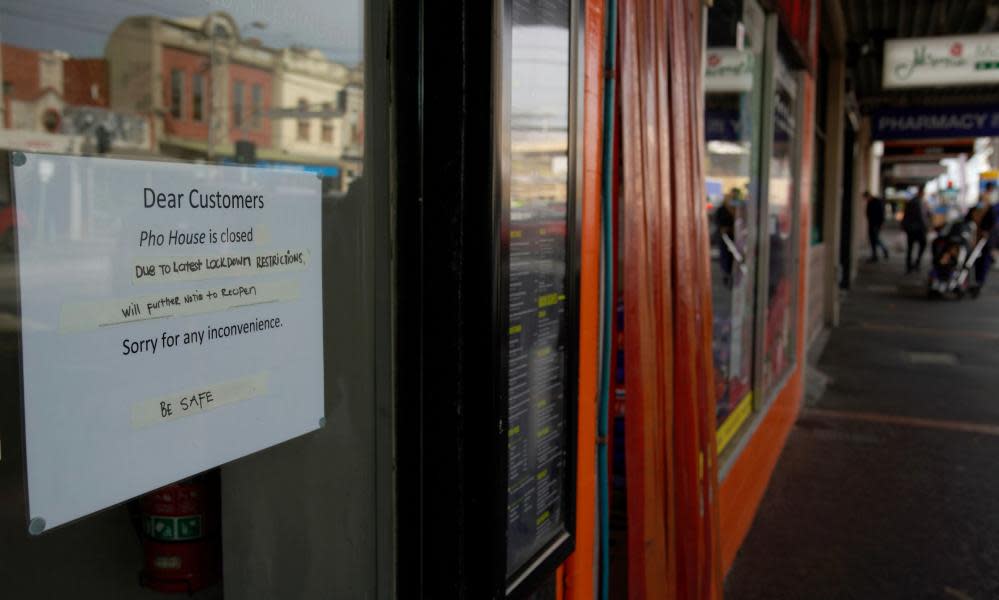Labor demands coronavirus supports remain as figures show 13 jobseekers per vacancy

Labor has seized on new figures showing there are now 13 jobseekers for every single job vacancy in Australia to argue against cutting government supports.
The figures show in May there were 1,635,286 people receiving jobseeker or youth allowance, compared with 124,500 vacancies, and that those welfare recipients collectively would stand to lose $900m if the $550 fortnightly coronavirus supplement was removed.
On Sunday Anthony Albanese snapped back at Scott Morrison’s accusation of Labor fearmongering about the future of the $70bn jobkeeper wage subsidy, arguing businesses still had no certainty despite government promises it would continue income support.
Related: Josh Frydenberg says Coalition will extend income support and may bring forward tax cuts
The government also announced a support package for national parks, with $233m injected into tourism and other infrastructure, claiming it would support up to 1,000 jobs in regional areas.
It is waiting until 23 July to reveal the future of jobkeeper and whether jobseeker benefits will be permanently raised by $75 a week or plunge back to the old rate of $40 a day – a cut opposed by unions, the social services sector and even employer groups.
According to Labor’s analysis of jobseeker recipient data and Australian Bureau of Statistics vacancy information, the odds of finding a job in Victoria are equal to the national average with 389,229 jobseekers and 28,700 vacancies, a ratio of 13 to 1.
In New South Wales the odds were a little better, with 476,784 jobseekers and 39,800 vacancies, a ratio of 11 to 1.
Before the second wave outbreak in Melbourne, Treasury projected that national unemployment would to rise to 8.5% this year. Despite the lack of available work, the government has argued that the $1,100 fortnightly rate of jobseeker with the coronavirus supplement could be acting as a disincentive to find work.
Unions have labelled it “cruel” of the government to suggest the unemployed are unwilling to work and argued it is using anecdotal evidence to prepare for cuts to welfare.
Linda Burney told Guardian Australia the government was “demonising unemployed people”, adding it was “very cruel the government doesn’t give some solace to people who are incredibly concerned about their future”.
Burney also criticised mutual obligation, which she said was supposed to create obligations on the person seeking work and the government.
“That’s not the way in which mutual obligation has been working – I think mutual obligation is important but it has to be reasonable, it has to deliver something [to the jobseeker] and not be punitive.”
On Friday, Morrison accused Labor of “fearmongering during a pandemic” for launching a website urging the government not to cut off jobkeeper and showing the number of people relying on the payment by local area.
Morrison labelled it “disgraceful” and “blatantly untrue” that the government was planning to cut off the jobkeeper wage subsidy in September.
“I have made it very clear that there would be a further stage of income support and to make people feel more uncertain in this climate I think is disgraceful and I think it reflects badly on their leadership.”
But Albanese didn’t resile from the attack, telling Sky News on Sunday the prime minister “wants everyone but him to be quiet” and refusing to tell more than 3 million Australians what will happen in September.
Related: Bringing forward tax cuts is giving to the wealthy when we can least afford it | Greg Jericho
“That is providing a risk to the economy – that is providing a great deal of anxiety out there.
“The prime minister, if he has another plan, should say what it is – it’s the prime minister who said repeatedly the economy would snap back in September.”
Related: Bringing forward tax cuts is giving to the wealthy when we can least afford it | Greg Jericho
In addition to the 23 July update on jobkeeper and jobseeker, the government is continuing to roll out industry specific support packages.
On Sunday the environment minister, Sussan Ley, and tourism minister, Simon Birmingham, announced an extra $233m for commonwealth national parks at Uluru-Kata Tjuta and Kakadu, Booderee on the NSW south coast, Christmas Island, and the Australian National Botanic Gardens in Canberra.
“New and improved infrastructure means more tourism, more jobs and better outcomes for Australians living in regional and remote areas, which is vital as we move through the economic challenges of Covid,” Ley said.
“This is an unprecedented funding injection for Parks Australia which has been planned over recent months to attract more visitors while providing jobs, improved accommodation and better facilities for staff and traditional owners. “

 Yahoo News
Yahoo News 
